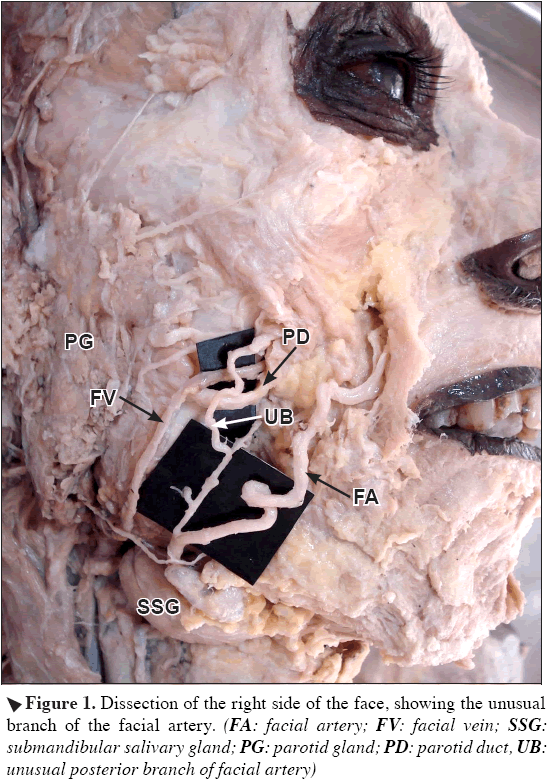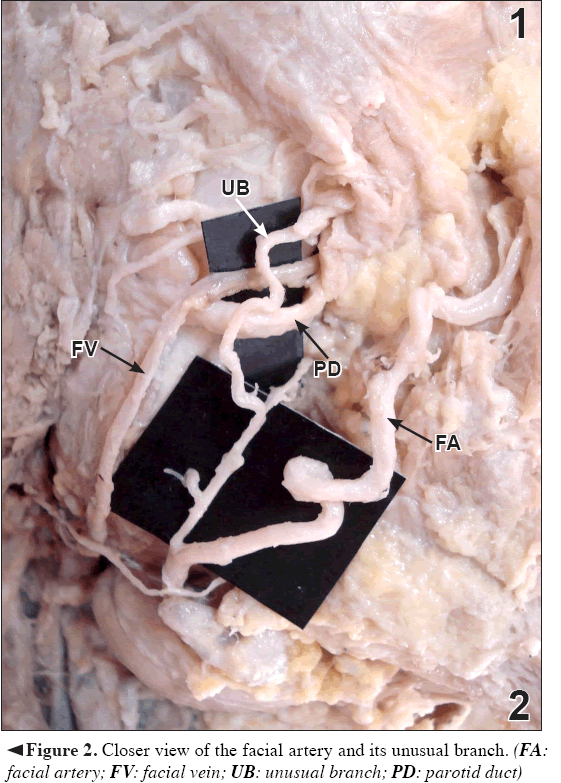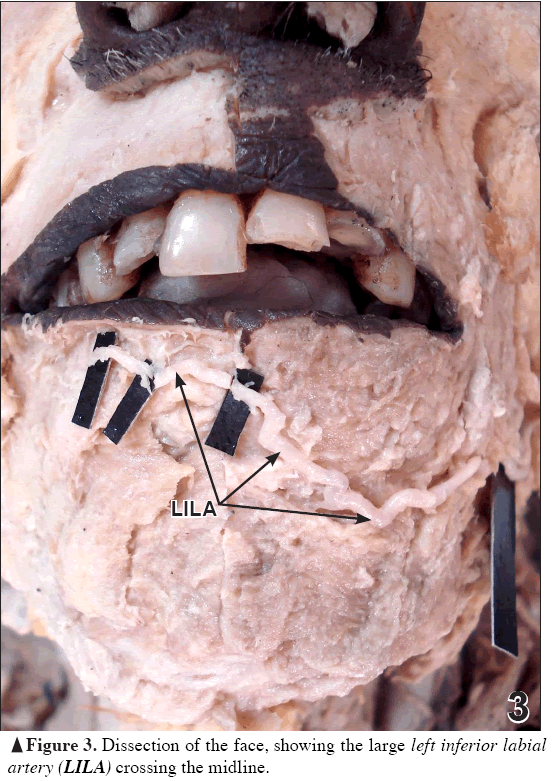Unusual posterior (premasseteric) branch of facial artery – a case report
Naveen Kumar, Satheesha Nayak B*, Surekha Shetty, Anitha Guru
Department of Anatomy, Melaka Manipal Medical College (Manipal Campus), International Centre for Health Sciences, Manipal University, Madhav Nagar, Manipal, Karnataka State, India.
- *Corresponding Author:
- Satheesha Nayak B
Professor and Head Department of Anatomy, Melaka Manipal Medical College (Manipal Campus), International Centre for Health Sciences, Manipal University, Madhav Nagar, Udupi District, Manipal, Karnataka State, 576104, India.
Tel: +91 820 2922519
E-mail: nayaksathish@yahoo.com
Date of Received: February 4th, 2011
Date of Accepted: August 15th, 2011
Published Online: September 24th, 2011
© IJAV. 2011; 4: 161–163.
[ft_below_content] =>Keywords
facial artery, external carotid artery, face, inferior labial artery
Introduction
Facial artery is the principal artery of the face. It is a branch of external carotid artery, given off in the carotid triangle of the neck. It runs upwards and forwards in the submandibular region winding around the superficial part of the submandibular gland and the base of the mandible. It enters the face after piercing the investing layer of deep cervical facia. On the face, the artery has a tortuous course to prevent it from getting pulled during the movements of mandible. The artery gives large named braches called inferior labial, superior labial and lateral nasal branches in the face. It ends by anastomosing with the dorsal nasal branch of ophthalmic artery. It gives only a few small unnamed braches posteriorly. We saw a large posterior branch of facial artery in the face. We discuss the clinical importance of the same in this paper.
Case Report
During the practical classes for first year medical students at Melaka Manipal Medical College (Manipal Campus) we found an unusual posterior (premasseteric) branch of the right facial artery. This variation was unilateral and was found in a cadaver aged approximately 65–70 years. The right facial artery gave a large posterior branch which had a tortuous upward course parallel to the facial artery (Figures 1, 2). First it ran upwards between the facial artery and facial vein and then crossed superficial to the parotid duct and facial vein. It ran deep to the zygomaticus major and minor muscles, and terminated by anastomosing with the infraorbital artery. The right transverse facial artery and inferior labial arteries were absent. The left inferior labial artery was large (Figure 3) and it crossed the midline and supplied the entire lower lip. It did not anastomose with right facial artery.
Discussion
Facial artery may show variations in its origin, course, termination and branching pattern. It may be totally absent and in such case, the transverse facial artery, ophthalmic artery and maxillary artery will supply its territory [1–3]. Facial artery may take origin along with the lingual artery as linguofacial trunk [3] or with the maxillary artery as maxillofacial trunk [4]. In its course the artery may fail to loop around the submandibular salivary gland [5]. Bergman et al. [3], have recorded several variations of the facial artery. According to them, the facial artery is frequently rudimentary. It may terminate as a submental artery, or as a labial, or lateral nasal artery. Some of the unusual branches of the facial include an ascending pharyngeal, superior laryngeal, tonsillar, sternocleidomastoid, maxillary, or sublingual branch [3]. The facial artery’s inferior and superior labial branches, are sometimes poorly developed or absent, in which case, they are replaced by the contralateral vessel, which is usually enlarged. In a study conducted by Niranjanthe, the facial artery terminated as an angular facial artery in 68% of cases, a lateral nasal vessel in 26% of cases, and a superior labial vessel in 4% of cases [6]. Loukas et al. have done an extensive study of facial artery in 284 faces [7]. In their study, the artery terminated by bifurcating into superior labial and lateral nasal arteries in 47.5% of cases. High origins of the facial artery have been reported in a few studies. Nayak [8] has reported the origin of the facial artery in the parotid gland and Mohandas et al. [9] have also reported a high origin (2 cm above the posterior belly of digastric muscle) of the facial artery. Presence of a considerably large posterior branch of facial artery, as reported here may be surgically important. This artery may bleed profusely during maxillofacial surgeries or might cause compression of the facial vein or parotid duct where it crosses them. The masseter muscle is often exploited by craniofacial surgeons in transposition operations to correct facial palsy, benign masseteric hypertrophy, or neurectomy-induced atrophy of the muscle. A clear understanding of the course of the premasseteric branch of the facial artery and its relations with adjacent structures is essential in maneuvering the masseter muscle safely. It is advisable for the plastic surgeons, radiologists, craniofacial surgeons and maxillofacial surgeons to be aware of such an unusual artery in the face.
References
- Blair CB Jr, Nandy K, Bourne GH. Vascular anomalies of the face and neck. Anat Rec. 1962; 144: 251–257.
- Tubbs RS, Salter EG, Oakes WJ. Unilateral agenesis of the facial artery with compensation by a giant transverse facial artery. Folia Morphol (Warsz). 2005; 64: 226–228.
- Bergman RA, Afifi AK, Miyauchi R. Compendium of human anatomical variations. Baltimore, Urban and Schwarzenber; 1988; 65.
- Pretterklieber ML, Krammer EB, Mayr R. A bilateral maxillofacial trunk in man: an extraordinary anomaly of the carotid system of arteries. Acta Anat (Basel). 1991; 141: 206–211.
- Marx C, Kumar P, Reddy S, Vollala VR. Bilateral variation of facial artery: a case report. Rom J Morphol Embryol. 2008; 49: 399–401.
- Niranjan NS. An anatomical study of the facial artery. Ann Plast Surg. 1988; 21: 14–22.
- Loukas M, Hullett J, Louis RG Jr, Kapos T, Knight J, Nagy R, Marycz D. A detailed observation of variations of the facial artery, with emphasis on the superior labial artery. Surg Radiol Anat. 2006; 28: 316–324.
- Nayak S. Abnormal intra-parotid origin of the facial artery. Saudi Med J. 2006; 27: 1602.
- Mohandas Rao KG, Rodrigues V, Shajan K, Krishnasamy N, Radhakrishnan AM. Unilateral high origin of facial artery associated with a variant origin of the glandular branch to the submandibular gland. International Journal of Anatomical Variations (IJAV). 2009; 2: 136–137.
Naveen Kumar, Satheesha Nayak B*, Surekha Shetty, Anitha Guru
Department of Anatomy, Melaka Manipal Medical College (Manipal Campus), International Centre for Health Sciences, Manipal University, Madhav Nagar, Manipal, Karnataka State, India.
- *Corresponding Author:
- Satheesha Nayak B
Professor and Head Department of Anatomy, Melaka Manipal Medical College (Manipal Campus), International Centre for Health Sciences, Manipal University, Madhav Nagar, Udupi District, Manipal, Karnataka State, 576104, India.
Tel: +91 820 2922519
E-mail: nayaksathish@yahoo.com
Date of Received: February 4th, 2011
Date of Accepted: August 15th, 2011
Published Online: September 24th, 2011
© IJAV. 2011; 4: 161–163.
Abstract
Facial artery is the main artery of the face. It is known to show some variations in its origin course and branching pattern. We found an unusual posterior (premasseteric) branch of the facial artery on the face. The right facial artery gave a large branch, which ran upwards behind the facial artery. This artery had a tortuous course and it terminated by anastomosing with the infraorbital artery. The transverse facial artery and inferior labial arteries were absent on the right side. The left inferior labial artery was large and it supplied the entire lower lip. Knowledge of this variation may be important for maxillofacial surgeons, plastic surgeons and radiologists.
-Keywords
facial artery, external carotid artery, face, inferior labial artery
Introduction
Facial artery is the principal artery of the face. It is a branch of external carotid artery, given off in the carotid triangle of the neck. It runs upwards and forwards in the submandibular region winding around the superficial part of the submandibular gland and the base of the mandible. It enters the face after piercing the investing layer of deep cervical facia. On the face, the artery has a tortuous course to prevent it from getting pulled during the movements of mandible. The artery gives large named braches called inferior labial, superior labial and lateral nasal branches in the face. It ends by anastomosing with the dorsal nasal branch of ophthalmic artery. It gives only a few small unnamed braches posteriorly. We saw a large posterior branch of facial artery in the face. We discuss the clinical importance of the same in this paper.
Case Report
During the practical classes for first year medical students at Melaka Manipal Medical College (Manipal Campus) we found an unusual posterior (premasseteric) branch of the right facial artery. This variation was unilateral and was found in a cadaver aged approximately 65–70 years. The right facial artery gave a large posterior branch which had a tortuous upward course parallel to the facial artery (Figures 1, 2). First it ran upwards between the facial artery and facial vein and then crossed superficial to the parotid duct and facial vein. It ran deep to the zygomaticus major and minor muscles, and terminated by anastomosing with the infraorbital artery. The right transverse facial artery and inferior labial arteries were absent. The left inferior labial artery was large (Figure 3) and it crossed the midline and supplied the entire lower lip. It did not anastomose with right facial artery.
Discussion
Facial artery may show variations in its origin, course, termination and branching pattern. It may be totally absent and in such case, the transverse facial artery, ophthalmic artery and maxillary artery will supply its territory [1–3]. Facial artery may take origin along with the lingual artery as linguofacial trunk [3] or with the maxillary artery as maxillofacial trunk [4]. In its course the artery may fail to loop around the submandibular salivary gland [5]. Bergman et al. [3], have recorded several variations of the facial artery. According to them, the facial artery is frequently rudimentary. It may terminate as a submental artery, or as a labial, or lateral nasal artery. Some of the unusual branches of the facial include an ascending pharyngeal, superior laryngeal, tonsillar, sternocleidomastoid, maxillary, or sublingual branch [3]. The facial artery’s inferior and superior labial branches, are sometimes poorly developed or absent, in which case, they are replaced by the contralateral vessel, which is usually enlarged. In a study conducted by Niranjanthe, the facial artery terminated as an angular facial artery in 68% of cases, a lateral nasal vessel in 26% of cases, and a superior labial vessel in 4% of cases [6]. Loukas et al. have done an extensive study of facial artery in 284 faces [7]. In their study, the artery terminated by bifurcating into superior labial and lateral nasal arteries in 47.5% of cases. High origins of the facial artery have been reported in a few studies. Nayak [8] has reported the origin of the facial artery in the parotid gland and Mohandas et al. [9] have also reported a high origin (2 cm above the posterior belly of digastric muscle) of the facial artery. Presence of a considerably large posterior branch of facial artery, as reported here may be surgically important. This artery may bleed profusely during maxillofacial surgeries or might cause compression of the facial vein or parotid duct where it crosses them. The masseter muscle is often exploited by craniofacial surgeons in transposition operations to correct facial palsy, benign masseteric hypertrophy, or neurectomy-induced atrophy of the muscle. A clear understanding of the course of the premasseteric branch of the facial artery and its relations with adjacent structures is essential in maneuvering the masseter muscle safely. It is advisable for the plastic surgeons, radiologists, craniofacial surgeons and maxillofacial surgeons to be aware of such an unusual artery in the face.
References
- Blair CB Jr, Nandy K, Bourne GH. Vascular anomalies of the face and neck. Anat Rec. 1962; 144: 251–257.
- Tubbs RS, Salter EG, Oakes WJ. Unilateral agenesis of the facial artery with compensation by a giant transverse facial artery. Folia Morphol (Warsz). 2005; 64: 226–228.
- Bergman RA, Afifi AK, Miyauchi R. Compendium of human anatomical variations. Baltimore, Urban and Schwarzenber; 1988; 65.
- Pretterklieber ML, Krammer EB, Mayr R. A bilateral maxillofacial trunk in man: an extraordinary anomaly of the carotid system of arteries. Acta Anat (Basel). 1991; 141: 206–211.
- Marx C, Kumar P, Reddy S, Vollala VR. Bilateral variation of facial artery: a case report. Rom J Morphol Embryol. 2008; 49: 399–401.
- Niranjan NS. An anatomical study of the facial artery. Ann Plast Surg. 1988; 21: 14–22.
- Loukas M, Hullett J, Louis RG Jr, Kapos T, Knight J, Nagy R, Marycz D. A detailed observation of variations of the facial artery, with emphasis on the superior labial artery. Surg Radiol Anat. 2006; 28: 316–324.
- Nayak S. Abnormal intra-parotid origin of the facial artery. Saudi Med J. 2006; 27: 1602.
- Mohandas Rao KG, Rodrigues V, Shajan K, Krishnasamy N, Radhakrishnan AM. Unilateral high origin of facial artery associated with a variant origin of the glandular branch to the submandibular gland. International Journal of Anatomical Variations (IJAV). 2009; 2: 136–137.









